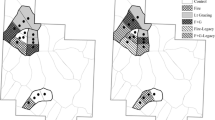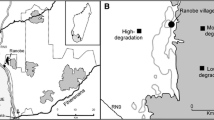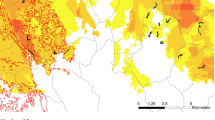Abstract
Long-term faunal responses to restoration efforts can be very different from those in the short term, but are often not quantified systematically to identify ways that maximise restoration outcomes. We report on a 9-year landscape-scale ecological experiment that tests the long-term responses of reptile populations to coarse woody debris (CWD) addition, reduced native macropod grazing, and prescribed fire. We found that reptile species richness was increased 9 years after CWD addition, as was the abundance of several common reptile species. Further, the more CWD was added to the system, the more benefits were afforded to reptiles. The positive effect of CWD depended on the surrounding vegetation structure and was greater in sites with low tree and shrub cover. Further, lower levels of macropod grazing appeared to lessen the effects of CWD addition in the long term. Our results show that restoration projects in open woodlands and scattered tree ecosystems should consider the addition of CWD as a fundamental element of their management actions. To maximise benefits of CWD addition for reptiles, we recommend a strategy of placing CWD in areas with low tree and shrub cover rather than areas with high tree and shrub cover. The addition of CWD in such areas would provide crucial shelter and foraging substrates for reptiles in a comparatively hostile portion of the landscape. Our study helps to establish guidelines for achieving long-lasting effects of ecosystem restoration for vertebrates and demonstrates the benefits of monitoring vertebrates over the long term.





Similar content being viewed by others
Data availability
The datasets analysed for this current study are available from the corresponding author on reasonable request.
References
Ackley JW, Angilletta MJ, DeNardo D, Sullivan B, Wu J (2015) Urban heat island mitigation strategies and lizard thermal ecology: landscaping can quadruple potential activity time in an arid city. Urban Ecosyst 18:1447–1459
Alexander ME (1982) Calculating and interpreting forest fire intensities. Can J Bot 60:349–357
Anderson DR (2007) Model based inference in the life sciences: a primer on evidence. Springer Science & Business Media, Berlin
Arnold TW (2010) Uninformative parameters and model selection using Akaike’s information criterion. J Wildl Manage 74:1175–1178. https://doi.org/10.2193/2009-367
Aronson J, Alexander S (2013) Ecosystem restoration is now a global priority: time to roll up our sleeves. Restor Ecol 21:293–296. https://doi.org/10.1111/rec.12011
Baiamonte G, Domina G, Raimondo FM, Bazan G (2015) Agricultural landscapes and biodiversity conservation: a case study in Sicily (Italy). Biodivers Conserv 24:3201–3216. https://doi.org/10.1007/s10531-015-0950-4
Barclay S, Ash JE, Rowell DM (2000) Environmental factors influencing the presence and abundance of a log-dwelling invertebrate, Euperipatoides rowelli (Onychophora: Peripatopsidae). J Zool 250:425–436. https://doi.org/10.1111/j.1469-7998.2000.tb00786.x
Barton K (2014) MuMIn: multi-model inference, R package version 1.9.13 edn. Springer, Berlin
Barton PS, Manning AD, Gibb H, Lindenmayer DB, Cunningham SA (2009) Conserving ground-dwelling beetles in an endangered woodland community: multi-scale habitat effects on assemblage diversity. Biol Conserv 142:1701–1709. https://doi.org/10.1016/j.biocon.2009.03.005
Barton PS, Manning AD, Gibb H, Wood JT, Lindenmayer DB, Cunningham SA (2011) Experimental reduction of native vertebrate grazing and addition of logs benefit beetle diversity at multiple scales. J Appl Ecol 48:943–951. https://doi.org/10.1111/j.1365-2664.2011.01994.x
Bates D, Maechler M, Bolker B, Walker S (2013) lme4: Linear mixed-effects models using Eigen and S4, R package version 1.0-5 edn. Springer, Berlin
Benayas JMR, Newton AC, Diaz A, Bullock JM (2009) Enhancement of biodiversity and ecosystem services by ecological restoration: a meta-analysis. Science 325:1121–1124. https://doi.org/10.1126/science.1172460
Briggs CJ, Borer ET (2005) Why short-term experiments may not allow long-term predictions about intraguild predation. Ecol Appl 15:1111–1117. https://doi.org/10.1890/04-1776
Brown GW (2001) The influence of habitat disturbance on reptiles in a Box-Ironbark eucalypt forest of south-eastern Australia. Biodivers Conserv 10:161–176. https://doi.org/10.1023/a:1008919521638
Brown GW, Dorrough JW, Ramsey DSL (2011) Landscape and local influences on patterns of reptile occurrence in grazed temperate woodlands of southern Australia. Landsc Urban Plan 103:277–288. https://doi.org/10.1016/j.landurbplan.2011.08.002
Burnham KP, Anderson D (2002) Model selection and multimodel inference: a practical information-theoretic approach. Springer-Verlag, New York
Core Team R (2019) R: a language and environment for statistical computing. R Foundation for Statistical Computing, Vienna
Côté SD, Rooney TP, Tremblay JP, Dussault C, Waller DM (2004) Ecological impacts of deer overabundance. Annu Rev Ecol Evol Syst 35:113–147
Croft P, Reid N, Hunter JT (2010) Experimental burning changes the quality of fallen timber as habitat for vertebrate and invertebrate fauna: implications for fire management. Wildl Res 37:574–581. https://doi.org/10.1071/WR10053
Cunningham RB, Lindenmayer DB (2017) Approaches to landscape scale inference and study design. Curr Landsc Ecol Rep 2:42–50. https://doi.org/10.1007/s40823-016-0019-4
Department of Environment (2017) White Box-Yellow Box-Blakely’s Red Gum grassy woodland and derived native grassland in community and species profile and threats database. http://www.environment.gov.au/cgi-bin/sprat/public/publicshowcommunity.pl?id=43. Accessed 16 May 2017
Driscoll DA (2004) Extinction and outbreaks accompany fragmentation of a reptile community. Ecol Appl 14:220–240
Driscoll D, Freudenberger D, Milkovits G (2000) Impact and use of firewood in Australia. CSIRO Sustainable Ecosystems, Canberra
du Prel J-B, Hommel G, Röhrig B, Blettner M (2009) Confidence interval or p-value?: part 4 of a series on evaluation of scientific publications. Dtsch Ärzteblatt Int 106:335
Evans MJ, Banks SC, Driscoll DA, Hicks AJ, Melbourne BA, Davies KF (2017) Short- and long-term effects of habitat fragmentation differ but are predicted by response to the matrix. Ecology 98:807–819. https://doi.org/10.1002/ecy.1704
Farnsworth LM, Nimmo DG, Kelly LT, Bennett AF, Clarke MF, Andersen A (2014) Does pyrodiversity beget alpha, beta or gamma diversity? A case study using reptiles from semi-arid Australia. Divers Distrib 20:663–673. https://doi.org/10.1111/ddi.12181
Fischer J, Lindenmayer DB, Cowling A (2004) The challenge of managing multiple species at multiple scales: reptiles in an australian grazing landscape. J Appl Ecol 41:32–44
Foster CN, Barton PS, Sato CF, Wood JT, MacGregor CI, Lindenmayer DB (2016) Herbivory and fire interact to affect forest understory habitat, but not its use by small vertebrates. Anim Conserv 19:15–25. https://doi.org/10.1111/acv.12210
Fox J (2003) Effect displays in R for generalised linear models. J Stat Softw 8:1–27
Friend GR (1993) Impact of fire on small vertebrates in mallee woodlands and heathlands of temperate Australia: a review. Biol Conserv 65:99–114. https://doi.org/10.1016/0006-3207(93)90439-8
Giron-Nava A et al (2017) Quantitative argument for long-term ecological monitoring. Mar Ecol Prog Ser 572:269–274
Goldin SR, Brookhouse MT (2015) Effects of coarse woody debris on understorey plants in a temperate Australian woodland. Appl Veg Sci 18:134–142. https://doi.org/10.1111/avsc.12120
Goldin SR, Hutchinson MF (2014) Coarse woody debris reduces the rate of moisture loss from surface soils of cleared temperate Australian woodlands. Soil Research 52:637–644
Goldin SR, Hutchinson MF (2015) Thermal refugia in cleared temperate Australian woodlands: coarse woody debris moderate extreme surface soil temperatures. Agric For Meteorol 214:39–47. https://doi.org/10.1016/j.agrformet.2015.07.011
Harmon ME et al (1986) Ecology of coarse woody debris in temperate ecosystems. Adv Ecol Res 15:133–302. https://doi.org/10.1016/s0065-2504(08)60121-x
Hervé M (2019) RVAideMemoire: testing and plotting procedures for biostatistics. R package version 0.9-73. https://CRAN.R-project.org/package=RVAideMemoire, R package version 0.9-73. edn
Hobbs RJ (2002) Fire regimes and their effects in Australian temperate woodlands. In: Bradstock RA, Williams JE, Gill AM (eds) Flammable Australia: the fires regimes and biodiversity of a continent. Cambridge University Presss, Cambridge, pp 305–326
Hobbs RJ, Norton DA (1996) Towards a conceptual framework for restoration ecology. Restor Ecol 4:93–110
Howland B, Stojanovic D, Gordon IJ, Manning AD, Fletcher D, Lindenmayer DB (2014) Eaten out of house and home: impacts of grazing on ground-dwelling reptiles in Australian grasslands and grassy woodlands. PLoS ONE 9:e105966. https://doi.org/10.1371/journal.pone.0105966
Howland BWA, Stojanovic D, Gordon IJ, Fletcher D, Snape M, Stirnemann IA, Lindenmayer DB (2016) Habitat preference of the striped legless lizard: implications of grazing by native herbivores and livestock for conservation of grassland biota. Austral Ecol 41:455–464. https://doi.org/10.1111/aec.12337
Johnson JB, Omland KS (2004) Model selection in ecology and evolution. Trends Ecol Evol 19:101–108. https://doi.org/10.1016/j.tree.2003.10.013
Letnic M, Dickman CR, Tischler MK, Tamayo B, Beh CL (2004) The responses of small mammals and lizards to post-fire succession and rainfall in arid Australia. J Arid Environ 59:85–114. https://doi.org/10.1016/j.jaridenv.2004.01.014
Lindenmayer D, Claridge A, Gilmore A, Michael D, Lindenmayer BD (2002) The ecological roles of logs in Australian forests and the potential impacts of harvesting intensification on log-using biota. Pac Conserv Biol 8:121–140
Mac Nally R, Parkinson A, Horrocks G, Conole L, Tzaros C (2001) Relationships between terrestrial vertebrate diversity, abundance and availability of coarse woody debris on south-eastern Australian floodplains. Biol Conserv 99:191–205
Macdonald BCT, Gillen J, Tuomi S, Newport J, Barton PS, Manning AD (2015) Can coarse woody debris be used for carbon storage in open grazed woodlands? J Environ Qual 44:1210–1215. https://doi.org/10.2134/jeq2014.10.0445
Mackensen J, Bauhus J, Webber E (2003) Decomposition rates of coarse woody debris—a review with particular emphasis on Australian tree species. Aust J Bot 51:27–37
Manning AD, Fischer J (2010) Scattered paddock trees: the living dead or lifeline to the future. In: Lindenmayer BD, Bennett AF, Hobbs RJ (eds) Temperate woodland conservation and management. CSIRO Publishing, Collingwood, pp 33–40
Manning AD, Lindenmayer DB, Cunningham RB (2007) A study of coarse woody debris volumes in two box-gum grassy woodland reserves in the Australian Capital Territory. Ecol Manage Restor 8:221–224. https://doi.org/10.1111/j.1442-8903.2007.00371.x
Manning AD, Wood J, Cunningham RB, McIntyre S, Shorthouse DJ, Gordon IJ, Lindenmayer DB (2011) Integrating research and restoration: a long-term experiment in south-eastern Australia. Aust Zool 35:648–663
Manning AD, Cunningham RB, Lindenmayer DB (2013) Bringing forward the benefits of coarse woody debris in ecosystem recovery under different levels of grazing and vegetation density. Biol Conserv 157:204–214. https://doi.org/10.1016/j.biocon.2012.06.028
McIntyre S et al (2010) Biomass and floristic patterns in the ground layer vegetation of box-gum grassy eucalypt woodland in Goorooyarroo and mulligans flat nature reserves, Australian capital territory. Cunninghamia 11:287–307
McIntyre S, Cunningham R, Donnelly C, Manning A (2015) Restoration of eucalypt grassy woodland: effects of experimental interventions on ground-layer vegetation. Aust J Bot 62:570–579
McIntyre S, Nicholls AO, Manning AD (2017) Trajectories of floristic change in grassland: landscape, land use legacy and seasonal conditions overshadow restoration actions. Appl Veg Sci. https://doi.org/10.1111/avsc.12321
Michael DR, Wood JT, Crane M, Montague-Drake R, Lindenmayer DB (2014) How effective are agri-environment schemes for protecting and improving herpetofaunal diversity in Australian endangered woodland ecosystems? J Appl Ecol 51:494–504. https://doi.org/10.1111/1365-2664.12215
Michael DR et al (2015) Ecological niche breadth and microhabitat guild structure in temperate Australian reptiles: implications for natural resource management in endangered grassy woodland ecosystems. Austral Ecol 40:651–660
Milchunas DG, Noy-Meir I (2002) Grazing refuges, external avoidance of herbivory and plant diversity. Oikos 99:113–130
Monasterio C, Salvador A, Iraeta P, Díaz JA (2009) The effects of thermal biology and refuge availability on the restricted distribution of an alpine lizard. J Biogeogr 36:1673–1684. https://doi.org/10.1111/j.1365-2699.2009.02113.x
Nopper J, Lauströer B, Rödel M-O, Ganzhorn JU (2017) A structurally enriched agricultural landscape maintains high reptile diversity in sub-arid south-western Madagascar. J Appl Ecol 54:480–488. https://doi.org/10.1111/1365-2664.12752
Pettit NE, Froend RH, Ladd PG (1995) Grazing in remnant woodland vegetation: changes in species composition and life form groups. J Veg Sci 6:121–130
Pringle RM, Webb JK, Shine R (2003) Canopy structure, Microclimate, and habitat selection by a nocturnal snake, Hoplocephalus bungaroides. Ecology 84:2668–2679. https://doi.org/10.1890/02-0482
Prober SM, Thiele KR, Higginson E (2001) The grassy box woodlands conservation management network: picking up the pieces in fragmented woodlands. Ecol Manage Restor 2:179–188. https://doi.org/10.1046/j.1442-8903.2001.00082.x
Prober SM, Lunt ID, Thiele KR (2002) Determining reference conditions for management and restoration of temperate grassy woodlands: relationships among trees, topsoils and understorey flora in little-grazed remnants. Aust J Bot 50:687–697
Prober SM, Thiele K, Koen T (2004) Spring burns control exotic annual grasses in a temperate grassy woodland. Ecol Manage Restor 5:131–134
Pulsford SA, Driscoll DA, Barton PS, Lindenmayer DB (2017) Remnant vegetation, plantings and fences are beneficial for reptiles in agricultural landscapes. J Appl Ecol. https://doi.org/10.1111/1365-2664.12923
Rambo JL, Faeth SH (1999) Effect of vertebrate grazing on plant and insect community structure. Conserv Biol 13:1047–1054
Santos T, Díaz JA, Pérez-Tris J, Carbonell R, Tellería JL (2008) Habitat quality predicts the distribution of a lizard in fragmented woodlands better than habitat fragmentation. Anim Conserv 11:46–56. https://doi.org/10.1111/j.1469-1795.2007.00146.x
Sato CF, Wood JT, Schroder M, Michael DR, Osborne WS, Green K, Lindenmayer DB (2014) Designing for conservation outcomes: the value of remnant habitat for reptiles on ski runs in subalpine landscapes. Landsc Ecol 29:1225–1236. https://doi.org/10.1007/s10980-014-0058-3
Shorthouse DJ et al (2012) The ‘making of’ the Mulligans Flat—Goorooyarroo experimental restoration project. Ecol Manage Restor 13:112–125. https://doi.org/10.1111/j.1442-8903.2012.00654.x
Smith H, Feber RE, Morecroft MD, Taylor ME, Macdonald DW (2010) Short-term successional change does not predict long-term conservation value of managed arable field margins. Biol Conserv 143:813–822. https://doi.org/10.1016/j.biocon.2009.12.025
Threatened Species Scientific Committee (2006) Advice to the Minister for the Environment and Heritage from the Threatened Species Scientific Committee (TSSC) on Amendments to the List of Ecological Communities under the Environment Protection and Biodiversity Conservation Act 1999 (EPBC Act). Department of Environment and Heritage, Canberra
Tzaros C (2005) Wildlife of the box-ironbark country. CSIRO Publishing, Clayton
Vitt LJ et al (2007) Detecting variation in microhabitat use in low-diversity lizard assemblages across small-scale habitat gradients. J Herpetol 41:654–663
Welsh AH (2011) Aspects of statistical inference, vol 916. Wiley, New York
White JW, Botsford LW, Hastings A, Baskett ML, Kaplan DM, Barnett LA (2013) Transient responses of fished populations to marine reserve establishment. Conserv Lett 6:180–191
Wickham H (2016) ggplot2: elegant graphics for data analysis. Springer-Verlag, New York
Yates CJ, Hobbs RJ (1998) Temperate eucalypt woodlands: a review of their status, processes threatening their persistence and techniques for restoration. Aust J Bot 45:949–973. https://doi.org/10.1071/BT96091
Acknowledgements
We thank Helen Crisp, Daniel Iglesias, Stuart Jeffress, Margaret Kitchin, Annie Lane, Sharon Lane, John Lawler, Nicki Munro, Sarah Sharp, David Shorthouse, Peter Mills, Dave Whitfield, and Grant Woodbridge for their support and involvement with the project; Steve Holliday and the many other reptile surveyors who have assisted with surveys since 2007; Steve Holliday and Chris Davey for assistance with distributing the CWD in 2007; Sam Banks, Ross Cunningham, Saul Cunningham, Murray Evans, Don Fletcher, Iain Gordon, David Lindenmayer, Sue McIntyre, David Shorthouse and Jeff Wood for providing advice to the overall project; Wade Blanchard, Ross Cunningham, Martin Westgate and Jeff Wood for statistical advice; Ross Cunningham and Jeff Wood for collaboration on the experimental framework design; and all the ACT Government staff that have assisted in all aspects of this project. Special thanks to Peter Mills, and Grant Woodbridge for assistance in implementing all the experimental treatments. Faunal surveys were covered by ANU ethics Protocols C.RE.44.05, C.RE.59.09, F.ES.10.10, A2011/017, A2014/35 and A2017/33; and ACT project licenses LT2005201, LT2007279, LT2009347, LT2010417, LT2014769, LT2015834 and LT2016905. Funding and in-kind logistic support for this project was provided by the ACT Government as part of an Australian Research Council Linkage Grant (LP0561817; LP110100126, LP140100209). ADM was supported by an Australian Research Council Future Fellowship for part of the study (FT100100358). The authors thank Philip Barton, Will Batson, Murray Evans, Sue McIntyre, Joanne McMillan and Chloe Sato and two anonymous reviewers for helpful and insightful comments on manuscript drafts.
Author information
Authors and Affiliations
Contributions
MJE and ADM designed the methodology, MJE performed the analysis, conceived the ideas and led the writing of the manuscript; JSN collected the data and conceived the ideas; ADM leads the Mulligans Flat—Goorooyarroo Woodland Experiment and designed the overall experimental framework in collaboration with Ross Cunningham and Jeff Wood (see Acknowledgements). He also collected the data and conceived the ideas. All authors contributed critically to the drafts and gave final approval for publication.
Corresponding author
Additional information
Communicated by Dirk Sven Schmeller.
Publisher's Note
Springer Nature remains neutral with regard to jurisdictional claims in published maps and institutional affiliations.
Electronic supplementary material
Below is the link to the electronic supplementary material.
Rights and permissions
About this article
Cite this article
Evans, M.J., Newport, J.S. & Manning, A.D. A long-term experiment reveals strategies for the ecological restoration of reptiles in scattered tree landscapes. Biodivers Conserv 28, 2825–2843 (2019). https://doi.org/10.1007/s10531-019-01798-5
Received:
Revised:
Accepted:
Published:
Issue Date:
DOI: https://doi.org/10.1007/s10531-019-01798-5




